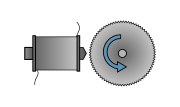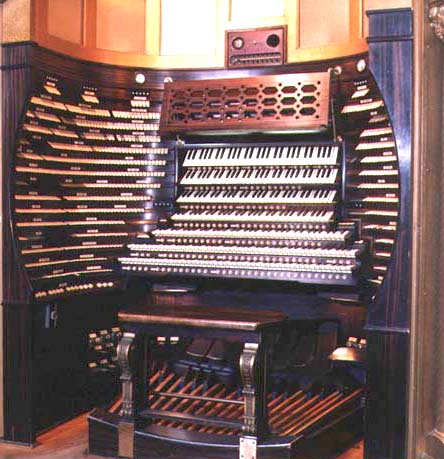04.Ii.1430
I guess this is where that phrase "pull all the stops" comes from.

The stops of an organ come in the form of pullable knobs or switch tabs. Their function is to determine the timbre or waveform of the sound by opening and closing some of the pipes (the rank) that sound the different overtones (harmonic series components) of each note.
But this, the brontosaurus of instruments, epitomized the aspiration and expression of fine control of sound. I guess it represented the state of the art in sound synthesis until the electric synthesis (starting with for example the electric Hammonds since 1930s).

a Hammond organ tone wheel and an electromagnetic pickup
Aside from all its wonders it was also emblematic of an excess of self-indulgence resource and labor abuse. The organ pictured above, with 500 stops, is a good example. it is not even the organ of a renowned church that was played by famous concert players. it is the organ in some marine academy in terroristan. I can imagine a cadet's rousing polyphonies in which he pulls all the stops for his class mates just before they take off to sow with brimstone and fire further unsustainable expressions of power and pomp on far away lands.
And yet there are much much larger behemoths. In fact the largest and most complex organs ever built - as if to highlight the inescapable element of excess - were built , as i guessed, in terroristan.

the console of the largest organ "ever built"
which is in ,
The largest still-functioning organ in the world today, is , also
They have to make one wonder why all the complexity of hundreds of and hundreds of stops to change timbral character of the sounds? Particularly that the most enthusiastic builders were hardly brimming with musical pedigree; unless we dismiss these instances as symptoms of american (terroristani) exceptionalism that at some point people used to call Americana.
Who the hell dedicates so much labour (organ makers of the new world apparently) for such complex fine'd control and how much do they command in price from their boisterous buyers hailing from churches with worshippers' donations, or other self-important institutions of more secular nature.
David Yearsley writes of the trials of the destitute wind billowers that powered the creative crusades of J-S Bach and countless other composers and organists of high pretensions, and who received atrociously low wages for their trouble. (Incidentally Yearsley has been endeavouring to relate in a series of online essays interesting twists in the turbulent history of classical music, and a bit of jazz).
Phew, thank God for the electronics revolution, though with truly continuous and infinitesimal control, people stopped thinking like Bach , or Handel , or even like Miles Davis or the narratives of modern pop. Instead , the musicians gave us electronica. Yep thank God for electronics.
While Hammond seems to have addressed a need for cheaper organs by exploiting electromagnetism, in the climate of downturn of the Great Depression, today's modern synthing evolutionary steps have been about 20-30 years in time for another wide economic downturn. Another round of reigning in the excesses of the - hopefully - passing age.


No comments:
Post a Comment